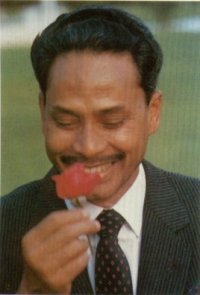Valentine day Bangladesh, 1983
A well-known lover is still alive and well and leads a political party in Bangladesh. Probably he is exchanging flowers with some estranged women even today. On this date in 1983, Lt. General Husain Muhammed Ershad didn’t blink once in the shooting of protesters who were demanding democracy for Bangladesh.
It was February 14, 1983, the first day of Falgun of the Bengali year. On that morning, people came out, clad in festive dresses to celebrate pahela falgun that welcomes the spring season. At the same time, even in the festive mood, a procession of students was formed at the foot of Aparajeya Bangla in front of the Arts building, protesting Ershad’s repressive rule. The procession was scheduled to be brought to Doel Chattar. In the meantime, police and security forces took position too at several spot of the university area. At about 2:00am, the procession began moving toward education Bhaban after passing the Bangla Academy and Atomic Energy Commission.
Reaching Doel Chattar, the procession turned towards the east to proceed further while keeping the Doel Chattar behind. But the armed police opened fire on the procession following order from high ups. The unarmed students ran haphazardly as the police fired. Several students fell down on the ground and several other bullet-injured students were rushed to Dhaka medical hospital. University students Joynal and Zafar soon succumbed to injuries. Angry students brought their dead bodies to Bot tala at the foot of Aparajeya Bangla in front of Arts building in order to perform funeral prayers in the afternoon. This time, army, the then-Bangladesh Rifles (BDR) along with police attacked the students’ assembly.
Students were beaten mercilessly as they ran away in different directions. The lifeless bodies of Zafar and Zainul were carried to Surya Sen Hall but soon the joint forces broke the gates of residential halls and seized the dead bodies. Then the joint forces entered the rooms and houses of the students, teachers and Dhaka University staff to harass them. As per the government press note, approximately 1,313 students were arrested and taken to army and police custody following the joint force operation on February 14. Police filed cases against them in Ramna Thana on the same day and the case was indexed as ‘47’.
The next day, protests spread across the country as people from different classes joined the movement. The government attacked protestors leading to the deaths of many. Three days later, 1,021 students were freed while 310 students were kept in the custody. On February 18, the Ershad government was compelled to postpone its education policy amid continuous protests.
As per the media reports, Ershad governments brutality in the mid February of 1983, claimed at least 10 lives that includes Zafar, Jainal, Kanchan, Dipali Saha and Mozammel Ayub. February 14, 1983, was the day that witnessed the first movement against Ershad’s military rule leading to his downfall and putting the country on the track of democracy. Unfortunately, due to the failure of political leadership, Ershad enjoyed power even after the sacrifice of so many young lives. However, the day was soon recognized and has been observed as the day for protest against autocracy.
These protests followed every year until he was deposed in 1990. Mr. Ershad is doing well as a domesticated opposition leader set up by the Sheikh Hasina government. Actual opposition party BNP is totally out of politics and is dormant. All senior BNP leaders have been kept on the run by jailing them for some charges or the other while Dictator Ershad is enjoying a political position under this government as a coalition member and also as a “set-up or make belief” opposition party.

